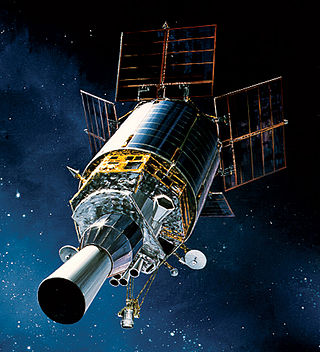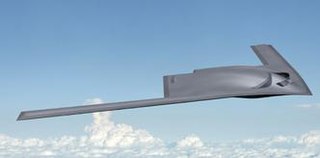Related Research Articles

The Northrop B-2 Spirit, also known as the Stealth Bomber, is an American heavy strategic bomber, featuring low-observable stealth technology designed to penetrate dense anti-aircraft defenses. A subsonic flying wing with a crew of two, the plane was designed by Northrop as the prime contractor, with Boeing, Hughes, and Vought as principal subcontractors, and was produced from 1987 to 2000. The bomber can drop conventional and thermonuclear weapons, such as up to eighty 500-pound class (230 kg) Mk 82 JDAM GPS-guided bombs, or sixteen 2,400-pound (1,100 kg) B83 nuclear bombs. The B-2 is the only acknowledged in-service aircraft that can carry large air-to-surface standoff weapons in a stealth configuration.

The Northrop Grumman RQ-4 Global Hawk is a high-altitude, remotely-piloted surveillance aircraft introduced in 2001. It was initially designed by Ryan Aeronautical, and known as Tier II+ during development. The RQ-4 provides a broad overview and systematic surveillance using high-resolution synthetic aperture radar (SAR) and electro-optical/infrared (EO/IR) sensors with long loiter times over target areas.

Northrop Grumman Corporation is an American multinational aerospace and defense company. With 95,000 employees and an annual revenue in excess of $30 billion, it is one of the world's largest weapons manufacturers and military technology providers. The firm ranked No. 101 on the 2022 Fortune 500 list of America's largest corporations.

The Defense Meteorological Satellite Program (DMSP) monitors meteorological, oceanographic, and solar-terrestrial physics for the United States Department of Defense. The program is managed by the United States Space Force with on-orbit operations provided by the National Oceanic and Atmospheric Administration (NOAA). The mission of the satellites was revealed in March 1973. They provide cloud cover imagery from polar orbits that are Sun-synchronous at nominal altitude of 830 km (520 mi).

The Northrop Grumman MQ-4C Triton is an American high-altitude long endurance unmanned aerial vehicle (UAV) developed for and flown by the United States Navy and Royal Australian Air Force as a surveillance aircraft. Together with its associated ground control station, it is an unmanned aircraft system (UAS). Developed under the Broad Area Maritime Surveillance (BAMS) program, the Triton is intended to provide real-time intelligence, surveillance and reconnaissance missions (ISR) over vast ocean and coastal regions, continuous maritime surveillance, conduct search and rescue missions, and to complement the Boeing P-8 Poseidon maritime patrol aircraft.

The Defense Support Program (DSP) is a program of the United States Space Force that operated the reconnaissance satellites which form the principal component of the Satellite Early Warning System used by the United States.

The National Polar-orbiting Operational Environmental Satellite System (NPOESS) was to be the United States' next-generation satellite system that would monitor the Earth's weather, atmosphere, oceans, land, and near-space environment. NPOESS satellites were to host proven technologies and operational versions of sensors that were under operational-prototyping by NASA, at that time. The estimated launch date for the first NPOESS satellite, "C1" or "Charlie 1" was around 2013. Issues with sensor developments were the primary cited reason for delays and cost-overruns.

The Northrop Grumman X-47B is a demonstration unmanned combat aerial vehicle (UCAV) designed for aircraft carrier-based operations. Developed by the American defense technology company Northrop Grumman, the X-47 project began as part of DARPA's J-UCAS program, and subsequently became part of the United States Navy's Unmanned Combat Air System Demonstration (UCAS-D) program. The X-47B is a tailless jet-powered blended-wing-body aircraft capable of semi-autonomous operation and aerial refueling.

KC-X was the United States Air Force (USAF) program to procure its next-generation aerial refueling tanker aircraft to replace some of their older Boeing KC-135 Stratotankers. The contest was for a production contract for 179 new tankers with estimated value of US$35 billion. The two contenders to replace the KC-135 aircraft were Boeing and EADS, following the elimination of US Aerospace, Inc. from the bidding process.

Space Systems Command (SSC) is the United States Space Force's space development, acquisition, launch, and logistics field command. It is headquartered at Los Angeles Air Force Base, California, and manages the United States' space launch ranges.

The Next-Generation Bomber was a program to develop a new medium bomber for the United States Air Force. The NGB was initially projected to enter service around 2018 as a stealthy, subsonic, medium-range, medium payload bomber to supplement and possibly—to a limited degree—replace the U.S. Air Force's aging bomber fleet. The Long Range Strike Bomber (LRS-B) heavy bomber program superseded the NGB program.

Advanced Extremely High Frequency (AEHF) is a constellation of communications satellites operated by the United States Space Force. They are used to relay secure communications for the United States Armed Forces, the British Armed Forces, the Canadian Armed Forces, the Netherlands Armed Forces and the Australian Defence Force. The system consists of six satellites in geostationary orbits. The final satellite was launched on 26 March 2020. AEHF is backward compatible with, and replaces, the older Milstar system and will operate at 44 GHz uplink and 20 GHz downlink. The AEHF system is a joint service communications system that provides survivable, global, secure, protected, and jam-resistant communications for high-priority military ground, sea and air assets.

The EADS/Northrop Grumman KC-45 was a proposed aerial refueling tanker aircraft based on the Airbus A330 MRTT. The United States Air Force (USAF) had ordered 179 KC-45As in the first stage of replacing the aging Boeing KC-135 Stratotanker tankers currently in service. However, the contest was reopened in July 2008, after Boeing's protest of the award was upheld. In response to the new contest, on 8 March 2010, Northrop Grumman announced it was abandoning its bid for the new contract, with its CEO stating that the revised bid requirement favoured Boeing. On 20 April 2010, EADS announced it was re-entering the competition and entered a bid with the KC-45. Eventually, the USAF selected the Boeing KC-46 Pegasus.
The Space Tracking and Surveillance System was a pair of satellites developed by the United States Missile Defense Agency (MDA) to research the space-based detection and tracking of ballistic missiles. Data from STSS satellites could allow interceptors to engage incoming missiles earlier in flight than would be possible with other missile detection systems. The STSS program began in 2001, when the "SBIRS Low" program was transferred to MDA from the United States Air Force. In December 2002, SBIRS Low Research & Development was renamed Space Tracking and Surveillance System (STSS).

The Joint Polar Satellite System (JPSS) is the latest generation of U.S. polar-orbiting, non-geosynchronous, environmental satellites. JPSS will provide the global environmental data used in numerical weather prediction models for forecasts, and scientific data used for climate monitoring. JPSS will aid in fulfilling the mission of the U.S. National Oceanic and Atmospheric Administration (NOAA), an agency of the Department of Commerce. Data and imagery obtained from the JPSS will increase timeliness and accuracy of public warnings and forecasts of climate and weather events, thus reducing the potential loss of human life and property and advancing the national economy. The JPSS is developed by the National Aeronautics and Space Administration (NASA) for the National Oceanic and Atmospheric Administration (NOAA), who is responsible for operation of JPSS. Three to five satellites are planned for the JPSS constellation of satellites. JPSS satellites will be flown, and the scientific data from JPSS will be processed, by the JPSS – Common Ground System (JPSS-CGS).

TASC, Inc., formerly known as The Analytic Sciences Corporation, is an American private defense contractor based outside Washington, D.C., in Chantilly, Virginia. Northrop Grumman owned TASC from 2001 to 2009, when it sold the unit to comply with new government conflict of interest rules.

The Long Range Strike Bomber (LRS-B) is a development and acquisition program to develop a long-range strategic bomber for the United States Air Force, intended to be a heavy-payload stealth aircraft capable of delivering thermonuclear weapons. Initial capability is planned for the mid-2020s. A request for proposal to develop the aircraft was issued in July 2014. The Air Force plans to procure at least 100 of the LRS-B aircraft at a cost of an estimated $550 million each, with potentially as many as 200 units being considered to enter service eventually. A development contract was awarded to Northrop Grumman for its B-21 Raider in October 2015. Due to the sensitive nature much about the project is highly classified and little information is available to the public. As of late 2019, it was known that construction of the aircraft had commenced, and on December 2, 2022, it was unveiled to the public.
The Northrop Grumman RQ-180 is an American stealth unmanned aerial vehicle (UAV) surveillance aircraft intended for contested airspace. As of 2019, there had been no images or statements released, but evidence points to the existence of the RQ-180 and its use in regular front-line service.

Orbital ATK Inc. was an American aerospace manufacturer and defense industry company. It was formed in February 9, 2015 from the merger of Orbital Sciences Corporation and parts of Alliant Techsystems (ATK). Orbital ATK designed, built, and delivered rocket engines, military vehicles, firearms, autocannons, missiles, ammunition, precision-guided munitions, satellites, missile approach warning systems, launch vehicles and spacecraft. The company was acquired by Northrop Grumman on June 6, 2018. The former Orbital ATK operations were renamed Northrop Grumman Innovation Systems and operated as a division until January 1, 2020 when a reorganization merged the operations into the company's other divisions.
The Weather System Follow-on Microwave (WSF-M) satellite is the United States Department of Defense's next-generation operational environmental satellite system. WSF-M will be a Sun-synchronous low Earth orbit (LEO) satellite with a passive microwave imaging radiometer instrument and hosted furnished Energetic Charged Particle (ECP) sensor. Space Operations Command intends to include ECP sensors on all future satellites for space weather monitoring, starting from the early 2020s. WSF-M was launched in April 2024 on a Falcon 9 Block 5 rocket from Vandenberg Space Force Base.
References
- ↑ "Defense Weather Systems Directorate Defense Weather Systems Directorate: DWSS Factsheet". Archived from the original on 25 June 2011. Retrieved 15 July 2011.
- ↑ "Northrop Grumman DWSS Home Page". Archived from the original on 7 October 2011. Retrieved 15 July 2011.
- ↑ "Northrop Grumman Receives Authorization from U.S. Air Force to Begin Work on Defense Weather Satellite System". Archived from the original on 2012-03-15. Retrieved 2011-05-27.
- ↑ "Proposed next-generation weather satellites get the ax". Spaceflight Now. January 24, 2012.
- ↑ "2015 Air Force RDT&E Budget Item Justification" (PDF). Retrieved 12 December 2017.
- ↑ Reuters: Northrop in $427 million U.S. Air Force satellite deal